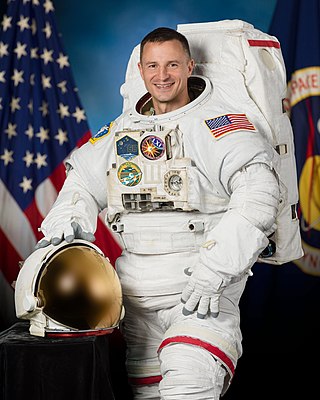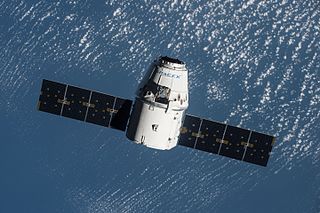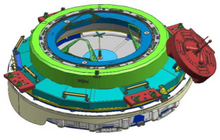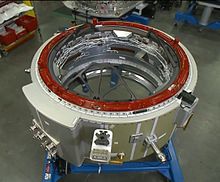
The International Space Station (ISS) is a large space station assembled and maintained in low Earth orbit by a collaboration of five space agencies: NASA, Roscosmos (Russia), JAXA (Japan), ESA (Europe), CSA (Canada), and their contractors. ISS is the largest space station ever built. Its primary purpose is performing microgravity and space environment experiments.

Uncrewed spaceflights to the International Space Station (ISS) are made primarily to deliver cargo, however several Russian modules have also docked to the outpost following uncrewed launches. Resupply missions typically use the Russian Progress spacecraft, European Automated Transfer Vehicles, Japanese Kounotori vehicles, and the American Dragon and Cygnus spacecraft. The primary docking system for Progress spacecraft is the automated Kurs system, with the manual TORU system as a backup. ATVs also use Kurs, however they are not equipped with TORU. The other spacecraft — the Japanese HTV, the SpaceX Dragon and the Northrop Grumman Cygnus — rendezvous with the station before being grappled using Canadarm2 and berthed at the nadir port of the Harmony or Unity module for one to two months. Progress, Cygnus and ATV can remain docked for up to six months. Under CRS phase 2, Cargo Dragon docks autonomously at IDA-2 or 3 as the case may be. As of December 2022, Progress spacecraft have flown most of the uncrewed missions to the ISS.

Harmony, also known as Node 2, is the "utility hub" of the International Space Station. It connects the laboratory modules of the United States, Europe and Japan, as well as providing electrical power and electronic data. Sleeping cabins for four of the crew are housed here.

Tranquility, also known as Node 3, is a module of the International Space Station (ISS). It contains environmental control systems, life support systems, a toilet, exercise equipment, and an observation cupola.

The NASA Docking System is NASA's implementation of the International Docking System Standard (IDSS), an international spacecraft docking standard promulgated by the International Space Station Multilateral Coordination Board. NDS is a spacecraft docking and berthing mechanism used on the International Space Station (ISS) and the Boeing Starliner and planned to be used on the Orion spacecraft. The international Low Impact Docking System (iLIDS) was the precursor to the NDS. NDS Block 1 was designed, built, and tested by The Boeing Company in Huntsville, AL. Design qualification testing took place through January 2017.

A Pressurized Mating Adapter (PMA) is a spacecraft adapter used on the International Space Station (ISS) to convert a Common Berthing Mechanism (CBM) interface to an APAS-95 docking port. Three PMAs are connected to the US Orbital Segment of ISS. PMA-1 and PMA-2 were launched with the Unity module in 1998 aboard STS-88; PMA-3 was launched in 2000 aboard STS-92. PMA-1 permanently connects the Unity and Zarya modules. IDA adapters have been installed on PMA-2 and PMA-3 which convert them to IDSS docking ports.

The process of assembling the International Space Station (ISS) has been under way since the 1990s. Zarya, the first ISS module, was launched by a Proton rocket on 20 November 1998. The STS-88 Space Shuttle mission followed two weeks after Zarya was launched, bringing Unity, the first of three node modules, and connecting it to Zarya. This bare 2-module core of the ISS remained uncrewed for the next one and a half years, until in July 2000 the Russian module Zvezda was launched by a Proton rocket, allowing a maximum crew of three astronauts or cosmonauts to be on the ISS permanently.

The US Orbital Segment (USOS) is the name given to the components of the International Space Station (ISS) constructed and operated by the United States National Aeronautics and Space Administration (NASA), European Space Agency (ESA), Canadian Space Agency (CSA) and Japan Aerospace Exploration Agency (JAXA). The segment consists of eleven pressurized components and various external elements, almost all of which were delivered by the Space Shuttle.

Docking and berthing of spacecraft is the joining of two space vehicles. This connection can be temporary, or partially permanent such as for space station modules.

SpaceX CRS-2, also known as SpX-2, was the fourth flight for SpaceX's uncrewed Dragon cargo spacecraft, the fifth and final flight for the company's two-stage Falcon 9 v1.0 launch vehicle, and the second SpaceX operational mission contracted to NASA under a Commercial Resupply Services (CRS-1) contract.

The International Docking System Standard (IDSS) is an international standard for spacecraft docking adapters. It was created by the International Space Station Multilateral Coordination Board, on behalf of the International Space Station partner organizations; NASA, Roscosmos, JAXA, ESA, and the Canadian Space Agency.

Andrew Richard "Drew" Morgan is a NASA astronaut from the class of 2013.

SpaceX CRS-7, also known as SpX-7, was a private American Commercial Resupply Service mission to the International Space Station, contracted to NASA, which launched and failed on June 28, 2015. It disintegrated 139 seconds into the flight after launch from Cape Canaveral, just before the first stage was to separate from the second stage. It was the ninth flight for SpaceX's uncrewed Dragon cargo spacecraft and the seventh SpaceX operational mission contracted to NASA under a Commercial Resupply Services contract. The vehicle launched on a Falcon 9 v1.1 launch vehicle. It was the nineteenth overall flight for the Falcon 9 and the fourteenth flight for the substantially upgraded Falcon 9 v1.1.

Dragon 2 is a class of partially reusable spacecraft developed, manufactured, and operated by American space company SpaceX, primarily for flights to the International Space Station (ISS). SpaceX also launches private missions, such as Inspiration4 and Axiom Space Missions. There are two variants of the Dragon spacecraft: Crew Dragon, a spacecraft capable of ferrying four crewmembers, and Cargo Dragon, a replacement for the original Dragon 1 used to carry freight to and from space. The spacecraft consists of a reusable space capsule and an expendable trunk module. The spacecraft launches atop a Falcon 9 Block 5 rocket and the capsule returns to Earth through splashdown.

SpaceX CRS-9, also known as SpX-9, is a Commercial Resupply Service mission to the International Space Station which launched on 18 July 2016. The mission was contracted by NASA and is operated by SpaceX using a Dragon capsule.

SpaceX CRS-15, also known as SpX-15, was a Commercial Resupply Service mission to the International Space Station launched 29 June 2018 aboard a Falcon 9 rocket. The mission was contracted by NASA and flown by SpaceX.

SpaceX CRS-17, also known as SpX-17, was a Commercial Resupply Services mission (CRS) to the International Space Station that was launched aboard a Falcon 9 rocket on 4 May 2019. The mission was contracted by NASA and was flown by SpaceX. An umbilical connection from the strongback remained attached to the spacecraft and is visible in photos taken of it approaching & attached to the ISS.

SpaceX CRS-18, also known as SpX-18, was SpaceX's 18th flight to the International Space Station under the Commercial Resupply Services program for NASA. It was launched on 25 July 2019 aboard a Falcon 9 rocket.

SpaceX CRS-21, also known as SpX-21, was a Commercial Resupply Service mission to the International Space Station which launched on 6 December 2020. The mission was contracted by NASA and was flown by SpaceX using a Cargo Dragon 2. This was the first flight for SpaceX under NASA's CRS Phase 2 contract awarded in January 2016. This was also the first Cargo Dragon of the new Dragon 2 variant, as well as the first Cargo Dragon flight that was docked at the same time as a Crew Dragon spacecraft. This mission used Booster B1058.4, becoming the first NASA mission to reuse a booster previously used on a non-NASA mission. This was also first time SpaceX launched a NASA payload on a booster with more than one previous flight.

SpaceX Crew-2 was the second operational flight of a Crew Dragon spacecraft, and the third overall crewed orbital flight of the Commercial Crew Program. The mission was launched on 23 April 2021 at 09:49:02 UTC, and docked to the International Space Station on 24 April at 09:08 UTC.






























